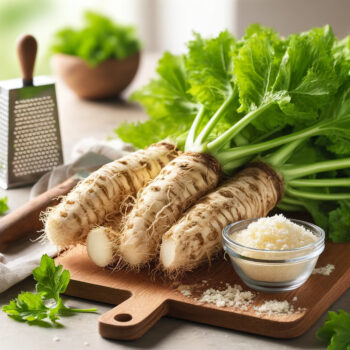Contributing writer for Wake Up World
A wonderfully zesty condiment to add to prime rib or other cuts of grass fed beef, horseradish has an unmistakable heat that radiates not so much in your mouth as in your nose.
While its exact origin isn’t certain, horseradish probably originated in the Mediterranean region, which alludes to its long, rich history.1 Greek mythology, for instance, considered horseradish to be worth its weight in gold.2
Cooks and healers continued making use of this root veggie in 15th century England, and centuries later the earliest American presidents grew it in their gardens. About 60% to 85% of the world’s horseradish production comes from the U.S., specifically Illinois.3
[pro_ad_display_adzone id=”110028″]
One rule of culinary thumb recommends that horseradish be red when it’s used for shrimp (typically mixed with a tomato base) and white when it’s made into a sauce to spread on beef. But as is true with many plant-based foods, both in ancient times and now, part of this pungent root’s value has been its medicinal capability.
Clinical evidence has indicated that horseradish has worked just as well or better than chemically concocted medicines. Horseradish has been successful in helping manage diseases, as well. Healthy and Natural World notes:
“Empirical research has now proved what our ancestors intuitively already knew. When treating certain conditions, horseradish is just as effective as chemically-synthesized antibiotics and it can sometimes even be superior to over-the-counter drugs.
Horseradish is particularly potent in the treatment of sinusitis and it clears upper respiratory passages, which helps with cold, influenza and lung congestion … When used as a natural drug, it comes without any side effects. At the same time, it provides us with some distinct culinary enjoyment.”4
However, it’s important to remember that heating horseradish can significantly alter the strength of the many healing compounds it contains, so eating it raw is recommended.
Horseradish Contains Compounds With Health-Enhancing Horsepower
It’s probably no surprise that one of the best uses for horseradish is that it can open up the stuffiest sinuses. This harkens back to one of its most popular uses as a throat-coat for hoarseness. Other conditions it remedies range from colds to urinary tract infections to kidney stones.
According to the Baseline of Health Foundation,5 horseradish may be helpful for relieving symptoms of several serious diseases and disorders, including high blood pressure, cancer and sinus infections. It may also help boost immune system function and fight other infections. Mother Earth News even asserted:
“Ounce for ounce, horseradish contains more medicinally active compounds than most other spices.
And they are very active — they can clear congestion, thin mucous, reduce inflammation, squelch cell-damaging oxidants, fight bacteria and viruses, relax muscles, stimulate the immune system — and even battle cancer. That makes the humble horseradish one special spice.”6
Variations of Healing Compounds in Horseradish
One book on the topic lists several healing compounds, and notes that “Horseradish has been reported to have antimicrobial, spasmolytic, cytotoxic, antiseptic, diuretic, stimulant and antioxidant properties.”7
Subfeed adds that horseradish also “acts as an antiviral, antibacterial, antifungal and antiparasitic medicine.”8 Clinical evidence notes that it’s these compounds that infuse it with health-enhancing potential.9
Oddly, horseradish root doesn’t have much of an odor until it’s nicked, cut or chewed, at which point its intensity becomes immediately evident. The smell indicates the presence of some potent, but completely natural, chemicals that impart such dramatic healing capability.
As a member of the Brassicaceae family along with mustard, wasabi and cabbage, horseradish comes with a storehouse of isothiocyanates (ITCs) such as glucosinolates (found only in Brassica plants) broken down from the volatile oil sinigrin and found to protect against cancer.10
The Ohio State University College of Food, Agricultural and Environmental Sciences11 says laboratory studies released by the American Institute for Cancer Research found that the presence of glucosinolates in food can:
- Decrease inflammation associated with many chronic illnesses, including cancer and cardiovascular disease
- Suppress enzymes known to activate carcinogens
- Stimulate enzymes that deactivate carcinogens and decrease the ability of cancer cells to spread
In a study conducted at the University of Illinois, horseradish was found to deliver 10 times more glucosinolate enzymes than broccoli.12 Lead researcher and associate professor in crop sciences Mosbah Kushad disclosed that just a little “dab” on your steak can communicate benefits and may provide the same health benefits as broccoli.
Sinigrin has a distinguished set of skills, as well. Another study links it with inhibiting lipid peroxidation by 71%, and it plays several roles in reducing the risk of several cancers.13
Horseradish Can Impact Several Types of Cancer
Further, the ITCs in horseradish (as well as wasabi root) were found in clinical trials to help reduce colon and lung cancer cell activity, and the higher the dosage, the weaker the cancer cells became — 30% to 68% weaker for colon cancer and 30% to 71% weaker for lung cancer cells.14
Horseradish contains more than two dozen other cancer-combating compounds. Researchers in England, Austria and New Zealand investigated one they called horseradish peroxidase (HRP), which was targeted as a treatment to help control the growth of breast and bladder cancer cells.15
After ingesting the volatile oil of horseradish, tests on human urine have shown that it can kill the bacteria that cause urinary tract infections. In fact, German herbal remedies suggest it kills gram-positive and gram-negative bacteria and candida and successfully treated many viral, bacterial, parasitic and fungal diseases.
The reduction in symptoms from chronically recurrent urinary tract infections (UTIs) after consumption of an herbal medicinal product containing horseradish has been reported as “statistically significant,” another study said.16
Healing and Immune-Boosting Horseradish Recipes
Used in combination with other healing herbs and plants with medicinal capabilities such as ginger, garlic, turmeric and apple cider vinegar, horseradish preparations have numerous applications. As always, use organic ingredients whenever possible.
One recipe calls for a 6-inch horseradish root peeled and grated into the juice of one lemon and a tablespoon of raw, organic honey and sealed in an airtight jar for 24 hours. One tablespoon, undiluted and taken three to four times a day is a heady concoction to soothe your throat and loosen your sinus congestion.
The Master Tonic recipe, which Subfeed17 says is a basic, all-around tonic dating back to medieval Europe, is used as an antibiotic to purify your blood, kill bacteria and increase blood and lymph circulation throughout your body, can be added to olive oil for use as a salad dressing or applied to wounds and infections.
Master Tonic
Ingredients
- 24 ounces organic apple cider vinegar
- 1/4 cup coarsely chopped garlic
- 1/4 cup chopped onion
- 2 fresh hot peppers, such as habaneros
- 1/4 cup grated fresh ginger
- 2 tablespoons horseradish
- 2 tablespoons turmeric powder (or the equivalent in turmeric root)
Procedure
Process the ingredients in a food processor but note that the apple cider vinegar is added later.
- Process the ingredients, then transfer the mixture to a Mason jar, filling it about two-thirds full.
- Pour in enough apple cider vinegar to fill the jar to the top.
- Close tightly and shake the jar until it’s well-combined. Do this several times a day while storing it in a cool, dry place for up to two weeks.
- After 14 days, strain the liquid through gauze or cheese cloth, squeezing the solid bits and setting them aside for use in recipes. The liquid part is then ready for medicinal use.
This mixture can be gargled and swallowed as a sore throat remedy. Take 1 tablespoon per day to strengthen your immune system and fight colds and flu. Master Tonic is safe for use by children and pregnant women in small doses, but take it with food until you’re used to it.
One thing to keep in mind when you’re handling horseradish, whether in food preparation or to make a tonic to treat health problems, is to wear plastic gloves for the same reason you do when handling some of the hottest peppers, such as jalapenos or habanero peppers. Also, keep it as far from your nose as possible!
Sources and References
- 1 Britannica, “Horseradish”
- 2 Horseradish.org, “Horseradish History”
- 3 St. Louis Magazine, May 17, 2018
- 4 Healthy and Natural World 2017
- 5 Baseline of Health Foundation, July 1, 2017
- 6 Mother Earth News March 31, 2014
- 7 Antioxidant Properties of Spices, Herbs and Other Sources, Horseradish, 01 January 2012, pp 347–351, Abstract
- 8, 17 Subfeed, “This Is The Most Powerful Natural Antibiotic Ever – Kills Any Infections In The Body” (Archived)
- 9 Journal of Agroalimentary Processes and Technologies 2013, 19(1), 111-115, Abstract
- 10 Eur J Nutr. 2008 May;47 Suppl 2:73-88
- 11 OSU January 15, 2016
- 12 Science Daily May 17, 2016
- 13 Nutr Cancer. 2004; 48(2):207-13
- 14 J Agric Food Chem. 2005 March 9;53(5):1440-4
- 15 Cancer Med. 2016 June;5(6):1194-203
- 16 Curr Med Res Opin. 2007 October;23(10):2415-22
Born and raised in the inner city of Chicago, IL, Dr. Joseph Mercola is an osteopathic physician trained in traditional and natural medicine. Board-certified in family medicine, Dr. Mercola served as the chairman of the family medicine department at St. Alexius Medical Center for five years and, in 2012, was granted fellowship status by the American College of Nutrition (ACN).
While in practice in the late 80s, Dr. Mercola realized the drugs he was prescribing to chronically ill patients were not working. By the early 90s, he began exploring the world of natural medicine and soon changed the way he practiced medicine.
In 1997, Dr. Mercola founded Mercola.com, which is now routinely among the top 10 health sites on the Internet. His passion is transforming the traditional medical paradigm in the United States. “The existing medical establishment is responsible for killing and permanently injuring millions of Americans… You want practical health solutions without the hype, and that’s what I offer.”
Visit Mercola.com for more information, or read Dr. Mercola’s full bio and resumé here.
[pro_ad_display_adzone id=”110027″]








